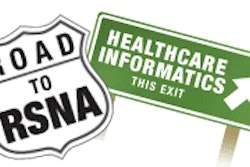DALLAS - Healthcare information technology isn't about software and computers. IT exists to help physicians make better treatment decisions, nurses and pharmacists deliver safer care, and consumers make better choices among treatment options, according to Dr. David Brailer, U.S. Health and Human Services National Coordinator for Health Information Technology.
Brailer outlined some of the goals and challenges his office faces in adopting and implementing a U.S. national health information network (NHIN), in a keynote address at the Healthcare Information and Management Systems Society (HIMSS) conference on Thursday.
"Healthcare is a remarkable and unique industry," Brailer said. "It is the only industry that gives days to our lives. Think about it -- how many things can you buy or use that add to your time on Earth?"
In a speech establishing the Office of National Coordinator for Health Information Technology (ONCHIT) last April, President Bush announced his goal of having interoperable electronic health records (EHRs) for most Americans within 10 years. To achieve this vision, Brailer's office sent out a request for information (RFI) in mid-November 2004. To date, ONCHIT has received more than 500 responses comprising more than 5,000 pages of information -- some good, some bad.
Although 22 respondents have publicly released their RFIs, Brailer noted that some RFI responses his office received were less than enthusiastic.
"We received more than a few that said to get our nose out of their business, and some that stated they would do everything in their power to obstruct our efforts," he said.
The official review of the RFIs will not be completed and results will not be released for a few weeks; however, Brailer shared several of the themes that have become visible in his analysis.
Respondents indicated that interoperability standards and policies for the NHIN require immediate attention from the federal government as well as public- and private-sector participants, Brailer said. Also cited was a need for governance of the NHIN that protects the public's interest, particularly the interplay between the public and private sectors.
Privacy was at the forefront of nearly all responses, Brailer said, and comments on this area were focused on how the NHIN should ensure that patients have control over who has access to their data. A regional approach to developing the NHIN's infrastructure was a consistent theme among the responses, he observed. There was a widespread belief that the federal government should not impose a one-size-fits-all structure, he said.
The RFI respondents also heavily endorsed an NHIN virtual network, tightly secured, that leveraged the public Internet. Financing for the venture will probably be accomplished through a shared investment between the private sector and the federal government.
Finally, respondents shared their concerns about running afoul of anti-inurement and antikickback laws, as well as some state laws that prohibit certain types of information sharing, he said.
Brailer listed four overarching goals he wants to accomplish for health IT:
- Inform clinical practice. This goal centers around efforts to bring EHRs directly into clinical practice.
- Interconnect clinicians. Interconnecting clinicians will allow information to be portable and to move with consumers from one point of care to another.
- Personalize care. Consumer-centric information is needed that can be used to manage wellness, assist with personal healthcare decisions, and choose providers.
- Improve population health. This requires the collection of anonymous, timely, and standardized clinical information that supports reporting for public health monitoring, bio-weapon surveillance, postmarket adverse event tracking, and quality benchmarking.
"There has been great progress in the past year, and many are optimistic about the future of health IT," he said. "However, there is much more to be done, and we have to work to address real issues and barriers that will halt the remarkable progress that is being made."
Brailer views healthcare IT as a cost-effective form of therapy, because when it is used as intended, it saves both lives and money. One of his biggest concerns is not that there will be low EHR adoption, but that there will be variable EHR adoption. Although clinicians are using EHRs today, some clinicians are adopting EHRs more readily than others -- creating an adoption gap based on the size of the practice, he said.
"This could prevent market forces and competition from improving healthcare," Brailer noted.
Another barrier that Brailer sees impeding the implementation of an NHIN is proprietary data. He believes that interoperability must be addressed now, or else widespread adoption of standalone EHRs will be a fait accompli.
"If interoperability is not solidified and built into EHRs, a generation of investment will be lost, as will an opportunity for fundamental improvement in care delivery," he cautioned.
Privacy and information control are also barriers that need to be addressed, according to Brailer. He said that the healthcare industry needs to be disciplined about developing the business rules, policies, and protections that get consumer health information where it needs to be and keeps it from going where it isn't supposed to be. In addition, the healthcare industry needs to take the lead in explaining to its public why electronic systems are preferable to paper.
"We have about nine years, 78 days, and 17 hours left to accomplish the goal of a national health information network," Brailer said. "All of us need to continue to support the groundswell of progress that has begun."
By Jonathan S. Batchelor
AuntMinnie.com staff writer
February 18, 2005
Related Reading
U.S. initiatives promote health information technology, November 26, 2004
Federal government to push for paperless hospitals, May 7, 2004
Copyright © 2005 AuntMinnie.com



















